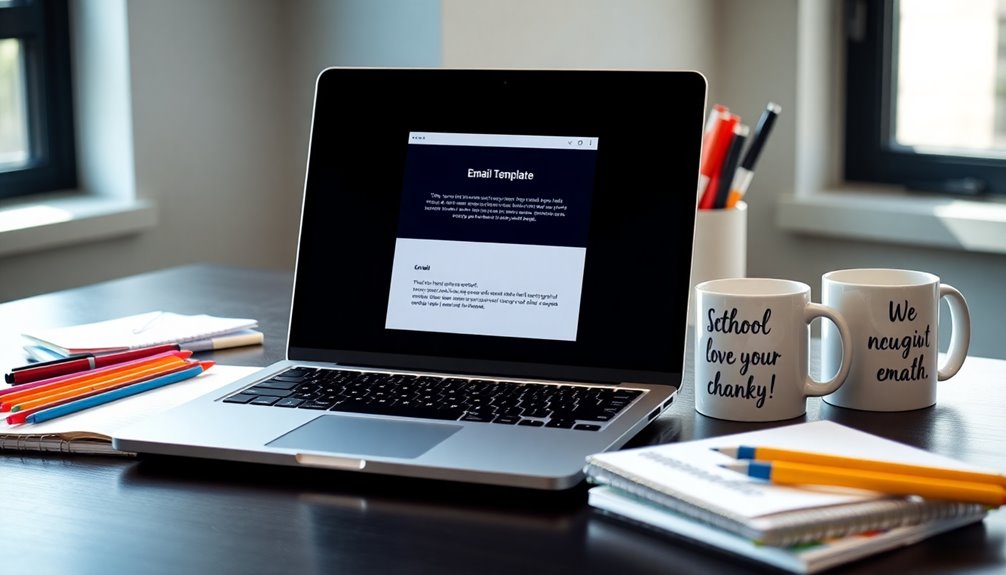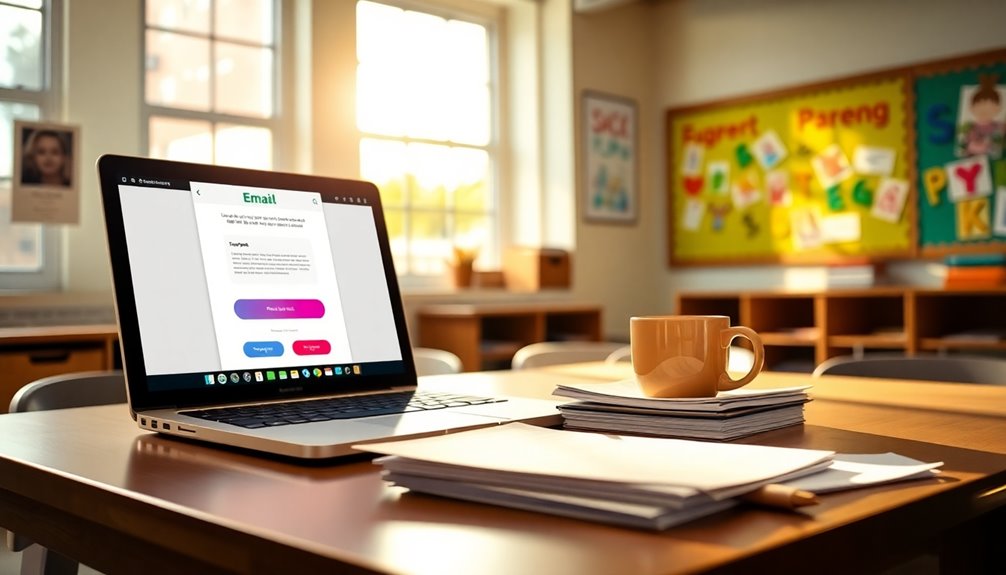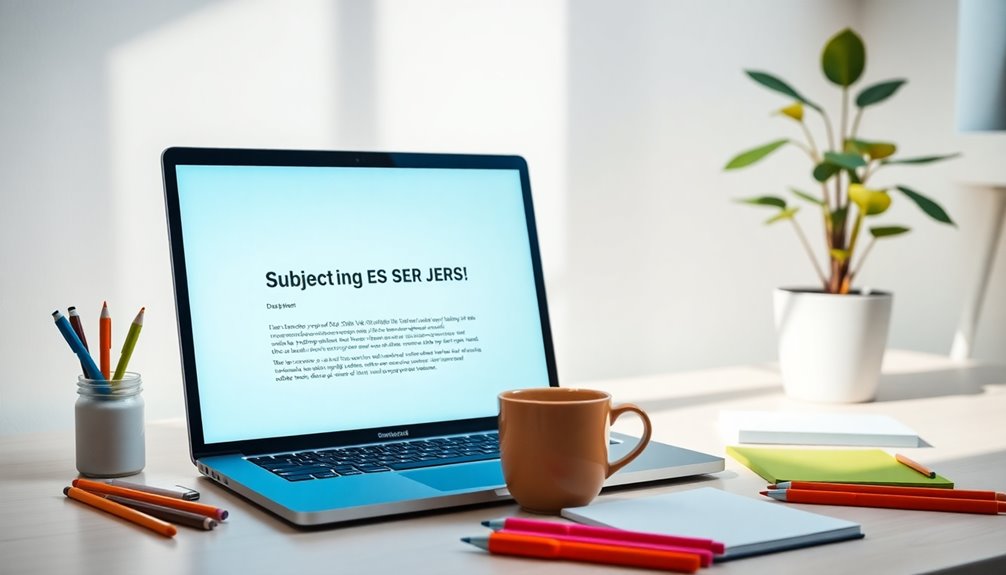To establish smooth communication with parents, start with an engaging subject line. Use a friendly yet professional tone to create a welcoming atmosphere. Personalize your message with specific details about the student, making parents feel valued. Keep it concise by focusing on one main topic and using bullet points for clarity. Always include actionable items and a clear call to action, encouraging prompt responses. Consistency is key—regular updates build trust and strengthen relationships. By refining your email strategies, you can enhance parental involvement and support students' success. Explore more tips to elevate your communication efforts even further!
Key Takeaways
- Start with a clear and engaging subject line to capture parent's attention and set the email's purpose.
- Maintain a friendly and professional tone, showing your commitment to open communication.
- Personalize the email by including specific details about the student to foster a connection.
- Use bullet points for concise information and focus on one main topic to avoid overwhelming parents.
- End with a clear call to action, encouraging timely responses and reinforcing ongoing dialogue.
Introduction

Effective communication between teachers and parents is essential for student success, and using email templates can make this process smoother and more efficient. By implementing effective templates, you can foster clear and consistent communication, creating a collaborative environment that benefits your students.
These templates save you time and reduce stress, providing ready-made structures for a variety of communication needs, from academic concerns to behavior updates.
When you customize these email templates, you ensure that your messages feel personalized and relevant, addressing each family's unique situation. This tailored approach not only conveys important information but also demonstrates your commitment to their child's success.
Having access to a library of templates for different scenarios allows you to tackle a wide range of topics, from positive feedback to urgent issues, with ease.
Streamlined communication through these structured templates enhances parent engagement and involvement in their child's education. When parents feel informed and included, it significantly contributes to improved student outcomes.
Builds Trust With Parents

Building trust with parents is a natural outcome of consistent communication through email templates. When you use different templates to provide regular updates about students, you foster transparency and openness. This helps parents feel more involved in their child's education, making them more likely to engage actively in school activities.
By sending FREE email updates that highlight student progress, behavior, and upcoming school events, you reinforce a collaborative relationship. Positive feedback in your e-mails can significantly enhance parents' trust in your commitment to their child's success. Personalizing these messages with specific details about achievements or improvement areas shows that you genuinely care, further solidifying that trust. Additionally, providing insights into the emotional well-being of students can help parents understand their child's overall development.
Utilizing well-structured email templates ensures your communication remains professional and organized. This approach reduces misunderstandings, allowing parents to see you as a reliable and trustworthy educator. Additionally, incorporating elements such as themed activities in your communication can create a more engaging and memorable experience for families.
As you practice this writing activity, remember that thoughtful, consistent communication is key to building lasting relationships with parents. When they feel informed and valued, trust naturally develops, paving the way for a supportive educational environment for students.
Clear and Concise Messaging

When communicating with parents, clarity is essential to ensure they grasp important information quickly. Crafting clear and concise messages helps enhance understanding and reduces the likelihood of miscommunication about crucial school events or student performance. You should always aim to use straightforward language, avoiding jargon that might confuse parents.
To maintain clarity, focus on one main topic at a time. This approach prevents overwhelming your recipients with excessive information, making it easier for them to digest what you're conveying.
Additionally, utilizing bullet points can highlight essential details efficiently, allowing parents to scan through the email effortlessly.
A well-crafted email subject that summarizes the content can significantly improve open rates. Parents will recognize the email's importance immediately, prompting them to read and respond.
Including actionable items or deadlines also encourages timely responses and boosts parent engagement in their child's education.
Crafting Effective Parent Emails

Crafting parent emails requires a thoughtful approach to ensure your message resonates. Start with a clear subject line like "Important Update on Student Progress," which captures attention and conveys urgency.
Use a friendly and professional tone throughout your writing, making sure your language is accessible to all parents. This fosters a positive connection.
Personalize the email by including the recipient's name and specific details about their child's performance or behavior. For instance, mention how their child is excelling in reading comprehension passages or how they can access a newsletter with free resources. Additionally, consider the importance of maintaining involvement in children's lives as it can significantly impact their emotional and academic success.
Keeping the email concise is crucial; use bullet points or numbered lists to highlight essential information, such as upcoming deadlines or key events.
Lastly, always end with a call to action. Encourage parents to respond with questions or feedback, reinforcing open dialogue and strengthening the home-school partnership. Additionally, consider incorporating elements of emotional alignment to create a more supportive environment for both parents and children.
Pro Tips for Maximizing Impact

To maximize the impact of your emails, focus on clarity and engagement from the very beginning. Start with concise subject lines that clearly communicate your email's purpose. This'll improve open rates and help parents quickly understand the importance of your message.
Incorporate bullet points for essential details in your email body, making it easier for parents to grasp key information without sifting through lengthy paragraphs.
Personalize your emails by addressing recipients by name and tailoring messages to specific concerns or updates. This fosters a sense of connection and engagement, making your communication feel more meaningful.
Consider scheduling emails to send at optimal times, like early mornings or just before weekends. This increases the likelihood of them being read and responded to promptly.
If you're using Email Templates, ensure they're designed to make students' experiences fun and engaging. You might even include a weekly newsletter with free resources that parents can access to support their children throughout the school year.
Lastly, regularly solicit feedback from parents about your communication effectiveness. Use their insights to refine your strategies for improved engagement and clarity.
Common Mistakes to Avoid

In the busy world of school communication, it's easy to slip into common pitfalls that can diminish the effectiveness of your emails. One major mistake is using overly complex language. Keep your messages straightforward; this increases clarity and understanding for parents. Remember, using clear and concise communication can greatly enhance parent engagement in the educational process.
Another issue is failing to include a clear subject line. A concise summary grabs attention and prevents important emails from being overlooked.
Don't forget to proofread for grammatical or typographical errors, as these can undermine your professionalism. Sending emails without a specific call-to-action is another misstep. Clearly outline any required responses or actions, so parents know what to do next, whether it's about Coloring Pages or Morning Work.
Also, neglecting to personalize your emails can make them feel generic. Always include the recipient's name and specific details to foster a more engaging relationship. Remember, your communication should fit the needs of K-12 personalized learning environments.
Lastly, be aware of your social media references and ensure they align with your school's Terms of Use. Additionally, consider how user consent plays a crucial role in establishing trust in digital communication. By avoiding these common mistakes, you can create a more effective and engaging communication channel with parents.
Parent-Teacher Conference Invitation Template

As the school year progresses, inviting parents to a Parent-Teacher Conference becomes essential for fostering strong communication. To create an effective Parent-Teacher Conference Invitation Template, start by clearly stating the date, time, and location of the meeting. This ensures parents have all the necessary information readily available.
Next, personalize your invitation by including the student's name and highlighting specific achievements or areas for improvement. This approach engages parents and encourages their attendance.
Additionally, include a brief list of agenda topics. This helps parents prepare questions or concerns in advance, fostering more productive conversations during the conference.
Don't forget to provide RSVP options within the template. This allows you to gauge attendance and make necessary arrangements. Incorporating elements of mental health awareness can enhance the communication between parents and teachers, ensuring a supportive environment for students.
Final Thoughts

Effective communication between teachers and parents is crucial for student success, and utilizing email templates can significantly streamline this process. By implementing customizable templates, you can address various concerns like academic challenges, behavioral issues, or even provide positive feedback. This approach not only saves time but also ensures consistent messaging, fostering better engagement with parents.
A well-structured email with a clear subject line increases the likelihood of parents reading and responding to your important messages. Additionally, recognizing patterns of emotional coldness in parent-teacher relationships can help improve communication dynamics. This enhancement in communication effectiveness can lead to improved relationships with families. Furthermore, incorporating mindfulness techniques in your communication can help reduce stress for both educators and parents, fostering a more positive interaction.
Regularly reviewing and updating your communication strategies based on parental feedback can also strengthen these connections, encouraging more involvement in students' education. Tracking the effectiveness of your email communication, such as open rates and responses, helps you refine your approaches. This data-driven method supports ongoing improvement in your engagement with families, ultimately benefiting the students.
Frequently Asked Questions
How Do You Write a Professional Email to a Parent?
To write a professional email to a parent, start with a clear subject line, greet them respectfully, state your message's purpose upfront, maintain a positive tone, and close with a courteous sign-off.
How Do You Document Parent Communication?
To document parent communication, keep a log detailing the date, method, and summary of discussions. Use a shared platform for easy access, maintain a consistent format, and regularly review to identify patterns and improve engagement.
How Do You Send a Parent Email About Student Behavior?
When you send a parent email about student behavior, start positively, clearly describe the specific issue, suggest solutions, and invite further discussion. This approach fosters collaboration and ensures a constructive dialogue for everyone involved.
How Can Schools Effectively Communicate With Parents?
To effectively communicate with parents, use clear, concise language and various channels—like emails, texts, and newsletters. Keep them informed about student progress and school events, fostering engagement and building trust for a supportive educational environment.









